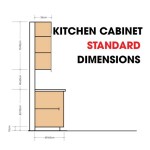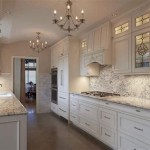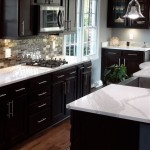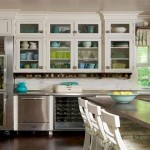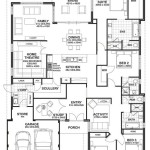Must-Haves For A New Kitchen
A kitchen is often described as the heart of the home. It is a multifaceted space serving as a center for culinary creativity, familial gatherings, and casual socializing. Embarking on a kitchen renovation or building one from scratch necessitates careful consideration of numerous elements to ensure optimal functionality, aesthetic appeal, and long-term value. Prioritizing essential components during the planning and execution stages can significantly impact the overall kitchen experience.
This article outlines the crucial features and appliances that should be considered during a kitchen construction or remodeling project. These elements are categorized and explained to provide a comprehensive guide for achieving a kitchen that meets both practical and aesthetic needs.
Essential Appliances: The Cornerstones of Functionality
Appliances represent a significant investment in a new kitchen. Selecting reliable and efficient models is paramount for long-term satisfaction. The "big four" appliances – refrigerator, oven/range, dishwasher, and microwave – form the core of a functional kitchen.
Refrigerator: Refrigerators are available in a variety of styles, including top-freezer, bottom-freezer, side-by-side, and French-door configurations. The choice depends on individual preferences and space constraints. Energy efficiency is a crucial factor, often indicated by the Energy Star rating. Consider the storage capacity required based on household size and cooking habits. Features such as adjustable shelves, humidity-controlled drawers, and water/ice dispensers can enhance usability.
Oven/Range: Ovens and ranges come in gas, electric, and dual-fuel options. Gas ranges offer responsive temperature control, while electric ovens generally provide more even heat distribution. Dual-fuel ranges combine the benefits of both. Convection ovens circulate hot air for faster and more even cooking. Self-cleaning features can significantly reduce maintenance efforts. Induction cooktops offer rapid heating and precise temperature control while remaining cool to the touch, enhancing safety.
Dishwasher: Dishwashers streamline the cleaning process and conserve water. Factors to consider include the number of place settings, wash cycles, and noise level. Energy Star-certified models minimize energy consumption. Features like adjustable racks, silverware baskets, and soil sensors contribute to efficient dishwashing. Consider a model with a sanitize cycle for improved hygiene. Look for quiet operation, especially if the kitchen is open to living or dining areas.
Microwave: Microwaves provide quick and convenient cooking and reheating options. Countertop, over-the-range, and built-in models are available. Over-the-range microwaves often incorporate a range hood for ventilation. Consider the wattage, size, and features such as pre-programmed cooking settings and sensor cooking. Inverter technology can provide more even cooking by delivering consistent power levels.
Countertops: Balancing Durability and Aesthetics
Countertops serve as the primary work surfaces in the kitchen, requiring a balance of durability, functionality, and aesthetic appeal. Material selection significantly impacts the overall look and feel of the kitchen. Common countertop materials include granite, quartz, marble, laminate, and wood.
Granite: Granite is a natural stone known for its durability and unique patterns. It is heat-resistant and scratch-resistant but can require sealing to prevent staining. The cost of granite varies depending on the rarity and quality of the stone. Granite adds a luxurious and timeless aesthetic to any kitchen.
Quartz: Quartz countertops are engineered stone made from crushed quartz and resin. They are non-porous, stain-resistant, and require minimal maintenance. Quartz offers a wide range of colors and patterns, providing design flexibility. While not as heat-resistant as granite, quartz is still a very durable option.
Marble: Marble is a luxurious natural stone with distinctive veining. It is heat-resistant but more porous and prone to staining and scratching than granite or quartz. Marble requires regular sealing and careful maintenance. Its elegant appearance makes it a popular choice for those seeking a high-end aesthetic.
Laminate: Laminate countertops are a cost-effective option made from layers of plastic bonded to a particleboard core. They are available in a wide variety of colors and patterns, mimicking the look of natural stone. Laminate is relatively easy to clean but is susceptible to scratching and heat damage.
Wood (Butcher Block): Wood countertops, often referred to as butcher block, provide a warm and natural aesthetic. They are durable and can be refinished to remove scratches or stains. Wood countertops require regular oiling to maintain their moisture content and prevent cracking. They are a popular choice for islands or smaller sections of countertop.
The choice of countertop material should align with the overall design aesthetic, budget, and usage patterns. Consider the level of maintenance required and the desired durability when making a selection.
Storage Solutions: Maximizing Space and Organization
Efficient storage is crucial for maintaining an organized and functional kitchen. Effective storage solutions maximize available space and streamline the cooking process. Cabinets, drawers, pantries, and shelving systems all play a role in optimizing kitchen storage.
Cabinets: Kitchen cabinets are available in a variety of styles, including base cabinets, wall cabinets, and tall cabinets. Base cabinets provide storage beneath countertops, while wall cabinets offer storage above. Tall cabinets are often used for pantry storage or appliance garages. Cabinet construction materials include solid wood, plywood, and particleboard. Door styles range from traditional raised-panel designs to contemporary flat-panel options. Features such as soft-close hinges and pull-out shelves enhance usability.
Drawers: Kitchen drawers provide accessible storage for utensils, cookware, and other kitchen essentials. Deep drawers are ideal for pots and pans, while shallow drawers are suitable for silverware and utensils. Drawer organizers help to keep items neatly arranged. Soft-close drawer slides prevent slamming and provide a more luxurious feel. Consider incorporating pull-out spice racks or knife blocks for added convenience.
Pantry: A pantry provides dedicated storage for dry goods, canned goods, and other non-perishable items. Walk-in pantries offer ample storage space, while pull-out pantries maximize space in smaller kitchens. Adjustable shelves allow for customization based on storage needs. Consider incorporating features such as spice racks, can organizers, and pull-out baskets to optimize pantry organization.
Shelving: Open shelving provides a visually appealing way to display dishes, glassware, and decorative items. Floating shelves offer a clean and modern look, while traditional shelves can be incorporated into cabinet designs. Consider the weight capacity of shelves and choose appropriate materials for support. Shelving can also be used to create a coffee station or bar area in the kitchen.
Effective kitchen storage solutions are essential for maintaining a clutter-free and functional space. Careful planning and consideration of individual storage needs are crucial for maximizing efficiency.
Lighting: Illuminating Functionality and Ambiance
Proper lighting is essential in a kitchen for both functionality and ambiance. A well-lit kitchen enhances safety, facilitates food preparation, and creates a welcoming atmosphere. Three primary types of lighting are typically used in kitchens: ambient, task, and accent lighting.
Ambient Lighting: Ambient lighting provides overall illumination for the kitchen. Recessed lighting is a popular choice for ambient lighting as it provides even and unobtrusive illumination. Pendant lights can also be used for ambient lighting, particularly over islands or peninsulas. Chandeliers can add a decorative touch and provide ambient light in larger kitchens. Consider using dimmers to adjust the level of ambient lighting based on the time of day and activity.
Task Lighting: Task lighting provides focused illumination for specific work areas, such as countertops, sinks, and cooktops. Under-cabinet lighting is essential for illuminating countertops for food preparation. Pendant lights can also be used as task lighting over islands or peninsulas. Consider using adjustable task lights to direct light where it is needed most. Proper task lighting enhances safety and efficiency during cooking and cleaning.
Accent Lighting: Accent lighting highlights specific features or areas in the kitchen, such as artwork, architectural details, or display shelves. Track lighting can be used to direct light onto specific areas. LED strip lights can be used to illuminate shelves or create a decorative effect under cabinets. Accent lighting adds visual interest and creates a more inviting atmosphere.
The combination of ambient, task, and accent lighting creates a well-balanced and functional kitchen lighting scheme. Consider the color temperature of the light bulbs to create the desired ambiance. Warm white light is often preferred for creating a cozy atmosphere, while cool white light provides brighter illumination for task lighting.
Ventilation: Maintaining Air Quality
Adequate ventilation is crucial for maintaining air quality in the kitchen. Range hoods effectively remove smoke, grease, and odors produced during cooking. Proper ventilation prevents the buildup of harmful pollutants and improves the overall comfort of the kitchen environment.
Range Hoods: Range hoods are available in a variety of styles, including under-cabinet, wall-mounted, and island hoods. Under-cabinet hoods are typically less expensive and suitable for smaller kitchens. Wall-mounted hoods are more powerful and provide better ventilation. Island hoods are designed for use over island cooktops and require ductwork to be installed in the ceiling. Consider the CFM (cubic feet per minute) rating of the range hood, which indicates its air-moving capacity. The appropriate CFM rating depends on the size of the cooktop and the type of cooking being done. Features such as adjustable fan speeds, automatic sensors, and easy-to-clean filters enhance usability.
In addition to range hoods, proper ventilation can be achieved through the use of windows and exhaust fans. Ensure that the kitchen has adequate natural ventilation by incorporating operable windows. Consider installing an exhaust fan in the ceiling to remove excess moisture and odors. Proper ventilation is essential for maintaining a healthy and comfortable kitchen environment.
Selecting the appropriate range hood depends on the cooktop location, cooking style, and budget. A powerful and efficient range hood contributes significantly to a cleaner and healthier kitchen environment.
Sink and Faucet: A Hub of Activity
The kitchen sink and faucet are essential components of a functional kitchen, serving as a central hub for food preparation, cleaning, and other tasks. Selecting the right sink and faucet is crucial for optimizing efficiency and convenience.
Sinks: Kitchen sinks are available in a variety of materials, including stainless steel, cast iron, composite, and fireclay. Stainless steel sinks are durable, easy to clean, and resistant to staining. Cast iron sinks are durable and provide excellent sound insulation. Composite sinks are made from a blend of materials, such as granite or quartz, and offer a variety of colors and textures. Fireclay sinks are durable and resistant to heat and stains. Sink configurations include single-bowl, double-bowl, and farmhouse styles. The choice depends on individual preferences and the type of tasks performed in the sink. Consider the size and depth of the sink bowl, as well as the location of the drain.
Faucets: Kitchen faucets come in a variety of styles, including pull-down, pull-out, and single-handle models. Pull-down faucets feature a sprayer head that pulls down from the faucet spout, while pull-out faucets feature a sprayer head that pulls out from the faucet body. Single-handle faucets allow for easy temperature and flow control. Faucet finishes include chrome, stainless steel, bronze, and black. Consider the height of the faucet spout and the reach of the sprayer head. Features such as touchless operation, water filtration, and adjustable spray patterns enhance usability. Opting for lead-free faucets contributes to water safety.
The selection of the sink and faucet should align with the overall design aesthetic and functional needs of the kitchen. A well-chosen sink and faucet can significantly enhance the efficiency and convenience of kitchen tasks.

16 Must Haves For Your New Kitchen Craig Allen Designs

5 Top Must Haves For Today S Kitchen

6 Must Haves For Your New Kitchen Remodel

6 Must Haves For Your New Kitchen Remodel

16 Must Haves For Your New Kitchen Craig Allen Designs

Kitchen Remodel Must Haves Wood Palace Kitchens Inc

10 Kitchen Cabinet Must Haves Showplace Cabinetry

Top 13 Must Have Kitchen Cabinet Accessories For Your Remodel

6 Must Haves For Your New Kitchen Remodel

10 Must Haves For Designing A New Kitchen Jkath Design Build Reinvent


